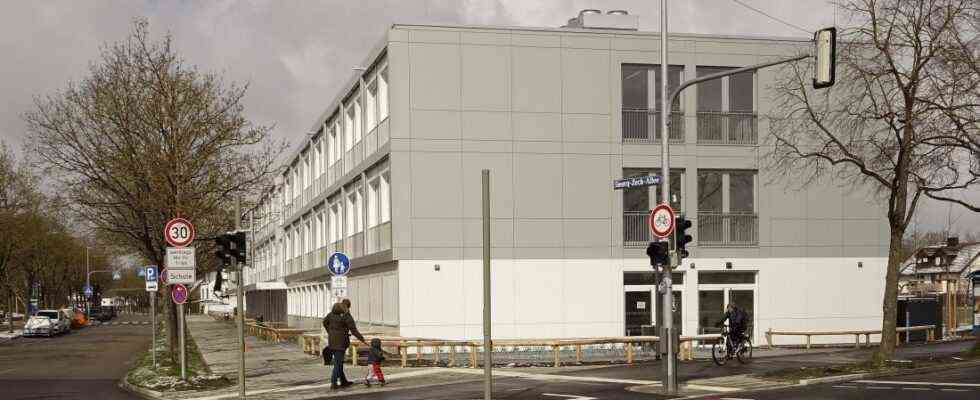When the summer holidays are over and the newly graduated high school students enter their container castle on Georg-Zech-Alle, then one group will be missing: students from the Hasenbergl. Because when it came to the allocation of places in the new grammar school in Feldmoching, the children from Hasenbergl went away empty-handed. And if the city doesn’t come up with something quickly, then they will in the future too. After just one year it becomes clear that the new grammar school is far too small. Those who suffer are precisely those students who come from one of the most socially disadvantaged districts of the city anyway.
The problem started with a mother, says Daniel Peters. He is chairman of the parents’ council at the primary school on Ittlingerstraße, which is a five-minute walk south of the Hasenbergl underground station. The mother wanted to send her son to the grammar school, which was advertised as a new school for the whole north of Munich. But she was rejected. The reason: the high school is full. “The same thing happened to several parents from our school,” says Peters. He became suspicious because no child from school made it to the new high school, despite good grades.
His distrust was justified, because now it turns out that it has not only affected the children from the elementary school on Ittlingerstrasse. Gerlinde Dunzinger has found out that almost all future high school students from Hasenbergl have to look around outside their city district. The SPD politician lives in Hasenbergl herself and is the child and youth representative in the local district committee.
After Peters told her about the problem, she picked up the phone and called the other elementary schools in the neighborhood. The same picture everywhere: both on Paulckestrasse and Thelottstrasse, where social housing is lined up and Diakonie is one of the largest employers. Dunzinger has around 15 Hasenberg students who now have to find a place at the grammar school somewhere else in Munich or in the neighboring communities. And there is nothing to suggest that this will change in the years to come.
“I am very sorry that I have to turn these students away,” says Martin Netter, principal of the new grammar school. “There were just too many registrations.” Around 180 children wanted to go to the transition container on Georg-Zech-Allee, he only had room for 150. And that’s only because he has already accepted five instead of three parallel classes for the second time. So far, the city has only planned three classes – around 90 students in each year. “I won’t be able to do that next year, otherwise we’ll soon run out of rooms,” says the rector. So the problem will only get worse in the years to come.
The new school was only opened last summer, as the first grammar school in the Feldmoching-Hasenbergl district. The fact that it is only called “Gymnasium Munich Feldmoching” and the Hasenbergl is missing in the name now turns out to be an unintended prophecy. The reason why the Hasenberglers are not accepted is simple: Netter calls it “distance criterion”. He selects the students from each elementary school so that they can better settle in the new school. And the schools that are closest to the train come first. Above all, these are the students from the residential estates in Feldmoching and Lerchenau. “I don’t go to districts, but according to the distance. I don’t know of any other neutral criterion,” says Netter. He would like to take in more children, including those from Hasenbergl. But he lacks the space for that.
“It feels like discrimination,” says Peters parents’ council. He himself comes from the Hasenbergl and knows that the district has neither good numbers in the social statistics nor a good reputation. You can believe that the rector has no bad intentions; after all, he only manages shortages. But in Hasenbergl the disadvantage has a structural effect. She doesn’t need bad will. The supposedly neutral criterion of distance is sufficient, the distance from everything that promises participation: from the city center, from money, from education or political influence. Whoever wants to escape this has to be twice as strong.
After Feldmoching they could have taken the bike
For the future high school students from the Hasenbergl this means: getting up earlier every day and commuting longer to a school that still accepts them. The Munich-North grammar school on Knorrstrasse has long since run out of space for them. So that leaves Unterschleißheim. Travel time from northern Hasenbergl: 40 minutes and three changes. After Feldmoching they could have taken the bike.
There, the container castle of the new grammar school is only a transitional quarter. It will get permanent housing when a new city district is pounded out of the field on the Lerchenauer field at the end of the decade. Then the school will have six parallel classes. “I need just as many now,” says Rector Netter. But when he gets it, Feldmoching will have grown by tens of thousands of residents. Including children, many of whom go to high school.
Local politicians have therefore long been warning that the new grammar school is too small. You are now calling for another high school. But the municipal education department sees it differently on request: “According to the current status of the needs assessment and planning, no further new construction of a high school is planned in the city district. One refers to plans in the Bayern barracks or in the vicinity of the pine garden in Freimann. But why should Freimann take in the students from the Hasenbergl when Feldmoching is too far away? It is quite possible that in ten years’ time it will still be: “Distance criterion, nothing against you.”

